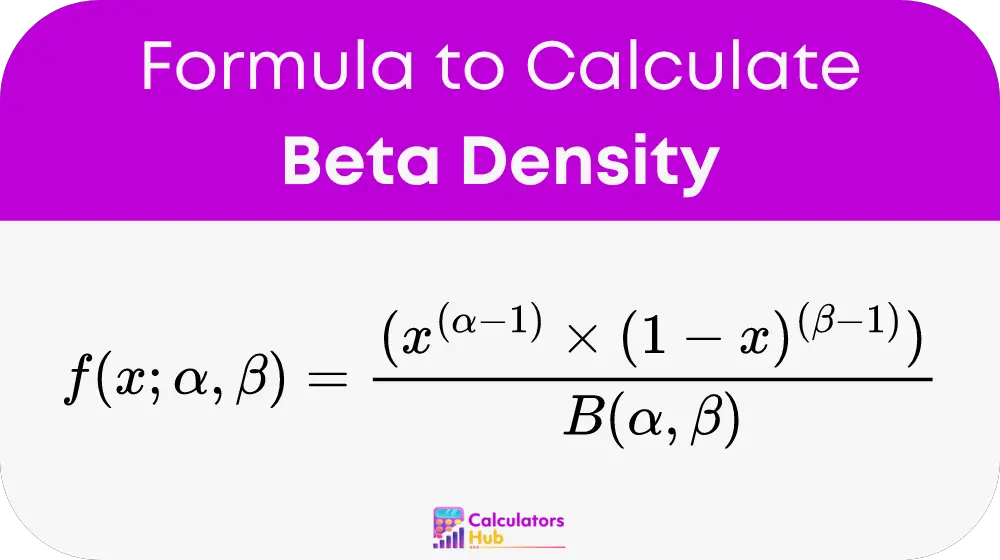The Beta Density Calculator is a valuable tool used in statistics and probability theory to calculate the probability density function (PDF) of the beta distribution. The beta distribution is a versatile and widely used continuous probability distribution that models variables limited to a range between 0 and 1. This distribution is particularly useful in fields such as Bayesian statistics, reliability engineering, and finance, where it helps to describe the likelihood of different outcomes within a bounded interval.
The Beta Density Calculator allows users to input specific parameters, such as the shape parameters α (alpha) and β (beta), and then calculates the corresponding density for a given value within the distribution's range. By understanding the beta density, users can make more informed decisions in scenarios involving uncertainty and variability.
Beta Density Calculation Formula
The beta density function is calculated using the following formula:

Where:
- f(x; α, β) = Beta density function
- x = Value for which the density is being calculated, where 0 ≤ x ≤ 1
- α = Shape parameter (alpha), must be greater than 0
- β = Shape parameter (beta), must be greater than 0
- B(α, β) = Beta function, which normalizes the distribution and is defined as:
B(α, β) = ∫[0, 1] t^(α - 1) * (1 - t)^(β - 1) dt
Steps for Calculation:
- Compute the Beta Function B(α, β): The Beta function can also be expressed using the Gamma function as:
B(α, β) = Γ(α) * Γ(β) / Γ(α + β)
Where Γ(n) is the Gamma function, defined as:
Γ(n) = ∫[0, ∞] t^(n - 1) * e^(-t) dt
- Calculate the Numerator: Compute the value x^(α - 1) * (1 - x)^(β - 1).
- Compute the Beta Density Function: Divide the result from step 2 by the Beta function value B(α, β) calculated in step 1.
This step-by-step process enables the precise calculation of the beta density function, which is essential for analyzing probabilities in constrained environments.
Common Terms and Conversion Table
To assist users in understanding the calculations and applications of the Beta Density Calculator, here is a table of common terms and conversions frequently encountered in statistical analysis.
| Term | Definition |
|---|---|
| Beta Distribution | A continuous probability distribution defined on the interval [0, 1] |
| Alpha (α) Parameter | A shape parameter influencing the distribution's skewness, must be > 0 |
| Beta (β) Parameter | A shape parameter influencing the distribution's skewness, must be > 0 |
| Beta Function (B(α, β)) | A normalization factor that ensures the total probability is 1 |
| Gamma Function (Γ(n)) | A function that extends the factorial function to real and complex numbers |
| Probability Density Function (PDF) | A function that describes the likelihood of a random variable to take on a particular value |
| Mean of Beta Distribution | E(X) = α / (α + β) |
| Variance of Beta Distribution | Var(X) = αβ / [(α + β)²(α + β + 1)] |
This table provides a quick reference for those using the Beta Density Calculator, ensuring accurate and informed calculations.
Example of Beta Density Calculator
Let's consider an example to illustrate how the Beta Density Calculator works.
Suppose you want to calculate the beta density for a value of x = 0.4 with shape parameters α = 2 and β = 5.
- Compute the Beta Function B(α, β):
Using the Gamma function:
B(2, 5) = Γ(2) * Γ(5) / Γ(2 + 5)
Knowing that:
Γ(2) = 1! = 1
Γ(5) = 4! = 24
Γ(7) = 6! = 720
B(2, 5) = (1 * 24) / 720 = 1/30
- Calculate the Numerator:
x^(α - 1) * (1 - x)^(β - 1)
= 0.4^(2 - 1) * (1 - 0.4)^(5 - 1)
= 0.4 * 0.1296 = 0.05184
- Compute the Beta Density Function:
f(x; 2, 5) = 0.05184 / (1/30) = 1.5552
Thus, the beta density for x = 0.4 with α = 2 and β = 5 is approximately 1.5552. This value indicates the probability density at that specific point within the distribution, providing insights into the likelihood of occurrences within the specified range.
Most Common FAQs
The Beta Density Calculator is used to calculate the probability density function (PDF) of the beta distribution for a specific value within the range [0, 1]. It helps in statistical modeling and analysis, particularly in scenarios involving constrained variables.
The shape parameters α and β are chosen based on the desired characteristics of the beta distribution. They control the distribution's skewness and variance, allowing the user to model different types of data distributions effectively.
The Beta Distribution is important because it can model random variables that are bind within an interval, such as probabilities and proportions. It is widely use in Bayesian statistics, reliability engineering, and various other fields to represent uncertainty and variability in data.